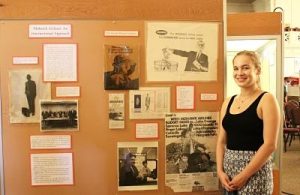Written by Erin Burke, ’18

Erin Burke ’18 with part of her finished exhibit at the Society
When you walk into a museum, the exhibits are neatly finished, cleanly executed, and seem almost timeless. The narrative presented to you speaks with the authority of fact. Blockaded behind glass cases and signs that say, “Please do not touch,” the artifacts take on a certain mysticism that often accompanies things that are “forbidden.” So how do those objects get there? Who chooses them? This summer, Erin Burke ’18 got to explore what happens behind-the-scenes at the Oneida County Historical Society.
The Oneida County Historical Society was founded to collect, preserve, and inform about the depth of history in Oneida County. Exhibits focus on local history, showing what larger national historical narratives looked like on a local scale. For example, there is currently a small exhibit at the society on prohibition in Utica focusing on prohibition’s effect on local businesses. Although Erin is a rising junior and a history major at Colgate, working at the society was her first experience with locally focused history.
The first part of Erin’s internship dealt with how objects arrive at the historical society. Erin was responsible for intake of artifacts into the society’s collections. This consisted of receiving the object(s), getting the donor’s information, writing detailed receipts and thank you notes, and accessioning each item into the society’s digital records. Almost all of the society’s collections are the result of small donations from local members of the community, although some people mail in contributions from across the nation. Because the collections process is reliant upon donations, the historical record is piecemeal and riddled with contingency. Once objects are entered onto the society’s digital records, each object is given a location, photographed, and placed into the depths of the society’s archives.
The second and main part of Erin’s internship at the historical society was to curate a new exhibition on Mohawk Airlines, in operation from 1945-1972. Passenger airlines arose in the United States after WWII, and the airline industry closely competed with the automobile industry for short distance travel. Although now the idea of air travel elicits thoughts of long TSA lines and cramped seats, air travel used to be glamorous. Air travel in the 1960s wasn’t just a way to get from here to there, it was an experience: perfectly coiffed stewardesses in designer uniforms strutted down the aisles, serving complimentary refreshments. Passengers often even put on their “Sunday Best” for their flights.
Mohawk Airlines was America’s largest regional air carrier in the 1960s. Mohawk served the Northeast, reaching as far South as Philadelphia, as far North as Montreal and as far West as Detroit. Previous historiography on the topic of Mohawk Airlines has focused on the tension between regional airlines and the federal regulatory board. The Civil Aeronautics Board was responsible for setting airlines rates and routes, as well as doling out government subsidies to regional airlines. In the Mohawk story, attention has been paid to the concept of “free enterprise in a regulated economy.” Articles primarily focus on how the airlines competed for customers without the ability to lower their rates.
Once the initial research had been done, and the appropriate secondary sources had been read, Erin’s next responsibility was to begin planning an exhibit. The beginning of a new exhibit begins with the dismantling of the previous one. It was Erin’s job to open up the cases and bypass the “Please do not touch” signs in order to clear the floor for her new exhibit. After designing a floor plan and pulling the artifacts she wished to display, Erin designed the layout for a total of 19 panels and 4 cases. This process drove home the idea that each exhibit is crafted, that each object is representative of a decision made by an unseen curator, and moreover that history is contested and contestable.
For Erin, the hardest part about creating her exhibit was choosing what information to display. The Mohawk Airlines story had so many aspects, but her challenge was to use the available artifacts to craft a narrative driven by a strong thesis. Erin decided to create two exhibits on Mohawk Airlines. Her first exhibit focuses on Mohawk’s integration into the Mohawk Valley community, arguing that Mohawk’s regional character was not defined solely in opposition to a federal regulatory body. Mohawk’s ties with Oneida County ran deep: its headquarters operated out of the Oneida County Airport. Her second exhibit focuses on parts of the Mohawk story often silenced: the role of women, people of color, and labor.

